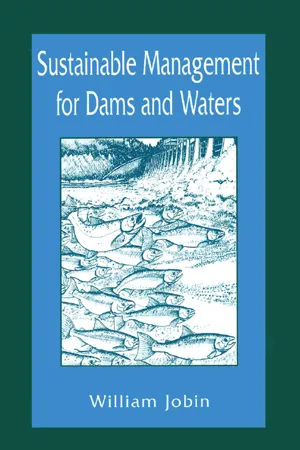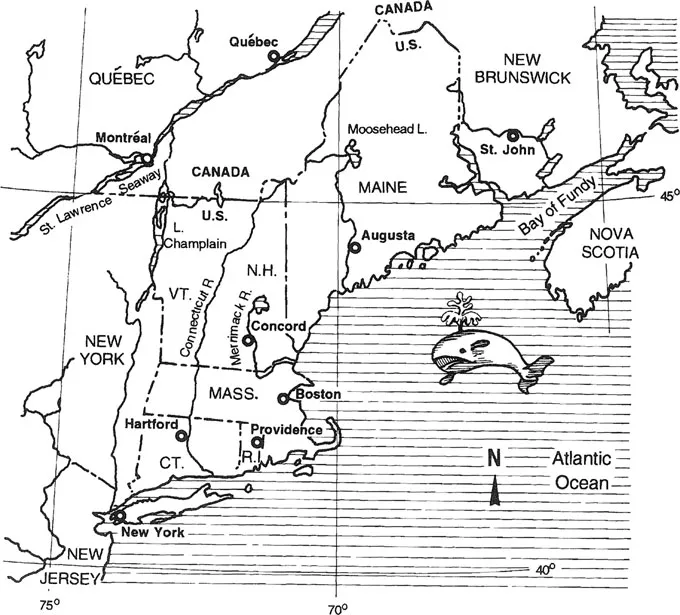![]()
SECTION II
Dams, Canals, and River Basins
In Section II we review specific instances of ecologically important water projects along the New England coast, then from the shores of Hudson Bay in Canada, across the breadth of the United States, to the Caribbean Sea, and finally down to Mar de la Plata in Argentina. Numerous case studies are cited to illustrate important aspects in the historical development of American water resources. In addition to the ecological impacts of dams and canals, considerable attention is given to parallel deterioration in the water quality of lakes, rivers, and harbors.
The myriad dams of the New England coastal waters are over 100 years old, continuing in operation only through the “Grace of God and large safety factors,” according to the late G. Williams of the Massachusetts Institute of Technology. But few of them serve their original purposes; most of them just damage the ecology of the rivers.
The history of the water and sewage systems for Boston Harbor is expounded in detail because they are the oldest water systems in North America, and because they are approaching a financial crisis that will need careful examination and management if severe ecological damage is to be avoided.
The importance of large shipping canals in affecting migration of exotic aquatic animals is illustrated in an examination of the St. Lawrence Seaway between Canada and the United States.
Toxic and hazardous waste problems affecting canals, reservoirs, and harbors are illustrated with three examples from North America. The long and tortured histories of Love Canal in New York and Neponset Reservoir and New Bedford Harbor in Massachusetts are used to demonstrate the recent emasculation of government programs to clean up industrial wastes. The striking influence of industrial and commercial corporations in modifying regulations for Superfund proceedings is portrayed.
Water resource planning is also analyzed for the tropical Americas. In the islands of the Caribbean Sea, dozens of hydroelectric dams were built after World War II, including 27 dams in the mountains of Puerto Rico. Fifty years later, the planning assumptions of the dam engineers have largely been negated by population growth, increased energy requirements, and the unyielding limit on available fresh water. The impact of these erroneous assumptions is described, including the recent and severe water shortages in Puerto Rico.
On the many rivers of Brazil, Uruguay, Paraguay, and Argentina, the largest hydroelectric dams in the world have recently been constructed. Many planning and engineering mistakes made in the U.S. in the past century are being repeated in South America now.
For some of the problems found in these case studies from both North and South America, specific solutions were derived, based on a broad analysis of historic and ecologic patterns. The most important is a proposal to prevent repetition of another ecologic disaster in Boston Harbor.
An institutional solution is proposed for abandoned dams in rivers of New England, focusing on restoration of habitats for migratory fish. The economic losses in an industrially contaminated reservoir in eastern Massachusetts are precisely calculated from property tax records over a 12-year period. This recent information, supplemented by a similar study of lakes in Maine, gives water planners and enforcement agencies more precise data to assess the economic impact of water pollution. The data should be useful to set fines for polluters, or to justify expensive remedial action.
Major faults in the process of water planning and dam design in the western U.S. are summarized for the benefit of dam builders throughout the Americas. The specific examples cited in Section II, of mistakes and local solutions across the broad range of conditions throughout the Western Hemisphere, provide a body of information from which general solutions are derived in Section III.
![]()
CHAPTER 3
New England
3.1 HISTORICAL INTRODUCTION
We are the Wabanakis — Children of the Dawn Country, People of the East. Five tribes made up our nation — Passamaquoddy, Penobscot, Micmac, Maliseet, and a tribe now gone that lived on the Kennebec River.… Long have the white men been among us. Yet some of us still remember the time when our lives were spent in hunting and fishing, and our villages were of wigwams instead of houses.
In the olden time our garments were of moose skin and fur…we fished with a bait of stone, well greased with moose tallow, on a line of moose sinew. Our lives were simple and glad, and our marriages were happy. Man and woman made their vow to the Great Spirit. In our old religion we believed that the Great Spirit who made all things is in everything, and that with every breath of air we drew in the life of the Great Spirit. — History of the Wabanakis, a people of Algonkian stock from the Atlantic Coast to the South of the St. Lawrence River, as told by Bedagi in the 19th Century. (From The Indian’s Book, 1987, edited by Natalie Curtis, Bonanza Books, New York.)
New England and other coastal cities of North America have suffered a great sea change in their economies at the close of the 20th Century. Although universities and technology-based industries have given the economy some degree of resiliency, their influence could not overcome the losses of fishing, whaling, and farming, which had always sustained the original indigenous peoples of the area, and which were quickly adopted by the immigrant population arriving from Britain and Europe in the 17th Century.
For the most part, these activities disappeared because of population growth and fundamental errors in the management of regional natural resources, especially the lakes, rivers, and oceans with their aquatic and marine life.
New England dams and rivers are not very large; the reason for describing them in detail here is that they have been evaluated more thoroughly and over longer periods of time than most river systems in the Americas. Over the last two decades, enormous and almost continuous water quality surveys have been conducted by government agencies, using the most current techniques and analytical methods.
Based on the extensive field data, intricate computer simulations of almost every one of the rivers in Massachusetts were developed. The models were used as operational regulatory tools to set allowable loadings for discharges and to set limits for discharge permits. The models incorporate hydraulic, chemical, and biological components, and are valuable representations of the aquatic ecology. Furthermore, they are documented in great detail in river reports issued by environmental agencies since the early 1970s. The locations of these invaluable and historic documents are listed in the appendices. Unfortunately, all of these documents point to serious problems in our attempts to manage a sustainable environment.
Dam builders, sanitary engineers, and environmental planners were principal actors in this mismanagement of coastal New England resources during the past three centuries. However, they received a great deal of help from political leaders, rapacious industries, and misguided whaling and fishing interests. Together with the swelling regional population, these actors gave a dramatic performance in the New England Tragedy of the Commons.
This historical review of the tragedy in New England was developed to provide the remaining planners and engineers with insights into, and guidelines for, avoiding such tragedies in the future. More importantly, principles were established for rehabilitating these resources, and managing them in a sustainable fashion as a way of revitalizing the regional ecology and economy. The future requires that these planners and engineers drastically revise their conceptual bases and approaches; thus, this book may not be pleasant for some readers.
3.2 CLIMATE AND HYDROLOGY
It is important to understand the climate and hydrology of this region, not only to comprehend the seasonal ecology of the rivers and bays, but also because some fundamental aspects of these seasonal changes have been neglected by dam, water, and environmental agencies in the past. In order to correct these omissions, it is helpful to examine the impact of hurricanes on the forests, rivers, and fish, and the impact of winter ice cover on toxic ecology in small reservoirs.
3.2.1 Summer Hurricanes
The history of hurricanes in New England usually begins with the 1938 hurricane that drove straight up Rhode Island Sound into Narragansett Bay (Figure 3.1). Since then, there were two major hurricanes in 1955, as well as several smaller hurricanes in the last decade. The Atlantic hurricane season of 1991 was the most prolific ever, but only Hurricane Bob reached New England on August 19th. It drove ashore slightly east of Narragansett Bay, doing considerable damage along the Rhode Island and Massachusetts shores near the state line.
Figure 3.1 New England states and major bodies of water. (Map by Paul Metcalf.)
3.2.2 Autumn Droughts
The driest season of the year in New England is the period from August through October when there is usually little or no rainfall, and the winter storms have not yet started. This dry period was the reason for building mo...

